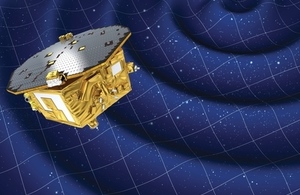Gravitational waves herald new era of physics and astronomy
Gravitational waves, predicted by Albert Einstein almost a century ago, have been detected for the first time.

Artist's impression of LISA Pathfinder. Credit: ESA.
These mysterious ripples in space-time are thought to be caused by massive celestial events such as neutron stars, black holes or supernovae collisions.
The first clear gravitational wave signal was picked up last September by the LIGO/Virgo collaboration and the information was rapidly passed to astronomers, including teams in the UK, allowing them to join a world-wide hunt to identify the source of the mysterious waves.
This exciting find, announced today by the LIGO/Virgo collaboration, is also big news for scientists involved in Europe’s LISA (Laser Interferometer Space Antenna) Pathfinder mission - a UK-led spacecraft (launched in December 2015) to test new technologies needed to measure gravitational waves in space. LISA Pathfinder has some of the most precise and advanced technology ever launched into space.
Professor Mike Cruise at the University of Birmingham said:
The announcement today of the first detection of gravitational waves by the Advanced LIGO Team has opened a new era in astronomy which will require observations and measurements from both ground and space borne detectors. The successful launch in December of LISA Pathfinder, designed to pave the way for a future gravitational wave detector in space, is the next step in opening up our new window on the Universe.
LISA Pathfinder is expected to reach its operational orbit in mid-February. After final checks, it will begin its six-month scientific mission on 1 March.
The UK’s involvement in LISA Pathfinder’s technology demonstration payload and the operational phase of the mission is funded by the UK Space Agency and was formerly funded by the Science and Technology Facilities Council (STFC). Airbus Defence and Space is the prime contractor for the mission, having built the spacecraft, as well as being the LISA Test Package (LTP) architect, on behalf of ESA and the participating Member States. SciSys UK Ltd developed the satellite’s on-board software and UK scientists from the University of Birmingham, the University of Glasgow and Imperial College London designed and built elements of the innovative and complex LTP. STFC RAL Space was involved in several technology development projects in the early stages of the mission in 2001.
At the core of LISA Pathfinder is a pair of identical 46 mm gold–platinum cubes separated by 38 cm, which will be isolated from all external and internal forces acting on them except one: gravity.
The mission will put these cubes in the purest free-fall ever produced in space and monitor their relative positions to astonishing precision, laying the foundations for gravitational wave observatories in space. Read more about LISA Pathfinder.